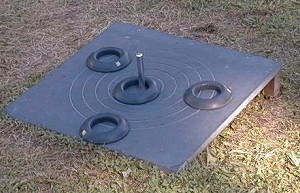Michael Flynn's Blog, page 34
August 5, 2012
August 1, 2012
Invention of Oxygen
Published on August 01, 2012 17:06
Lamarck's Birthday
Published on August 01, 2012 17:05
July 30, 2012
The Gigi Cup
2012 Flynn Quoit Tournament
 The 2012 Annual Flynn Quoits Tournament, hosted by my brothers out in Colorado (to the bemusement of the Westerners) has been held and, although he neglects to inform TOF who won the treasured Gigi, bro Kevin, sends along the photos. (Quoits is pronounced kwātes.) Many of these mean nothing to TOF's Faithful Reader, but there are number of shots that display the Art of the Quoit, as practiced in the Lehigh Valley of Pennsylvania (and now in one small corner of Colorado). Note the athletic form, the graceful toss, the follow-through. Kissing the quoit after making a ringer is optional.
The 2012 Annual Flynn Quoits Tournament, hosted by my brothers out in Colorado (to the bemusement of the Westerners) has been held and, although he neglects to inform TOF who won the treasured Gigi, bro Kevin, sends along the photos. (Quoits is pronounced kwātes.) Many of these mean nothing to TOF's Faithful Reader, but there are number of shots that display the Art of the Quoit, as practiced in the Lehigh Valley of Pennsylvania (and now in one small corner of Colorado). Note the athletic form, the graceful toss, the follow-through. Kissing the quoit after making a ringer is optional.
The game of quoits involves hard rubber rings (the quoits) and slate boards tilted at an angle and with a hub in the center. This is unlike Philadelphia quoits or New Jersey quoits.
Slide show of the Flynn Tournament: http://www.flickr.com/photos/kflynncolo/sets/72157630814063534/show/
Why this is not an Olympic sport, I do not know.
 The 2012 Annual Flynn Quoits Tournament, hosted by my brothers out in Colorado (to the bemusement of the Westerners) has been held and, although he neglects to inform TOF who won the treasured Gigi, bro Kevin, sends along the photos. (Quoits is pronounced kwātes.) Many of these mean nothing to TOF's Faithful Reader, but there are number of shots that display the Art of the Quoit, as practiced in the Lehigh Valley of Pennsylvania (and now in one small corner of Colorado). Note the athletic form, the graceful toss, the follow-through. Kissing the quoit after making a ringer is optional.
The 2012 Annual Flynn Quoits Tournament, hosted by my brothers out in Colorado (to the bemusement of the Westerners) has been held and, although he neglects to inform TOF who won the treasured Gigi, bro Kevin, sends along the photos. (Quoits is pronounced kwātes.) Many of these mean nothing to TOF's Faithful Reader, but there are number of shots that display the Art of the Quoit, as practiced in the Lehigh Valley of Pennsylvania (and now in one small corner of Colorado). Note the athletic form, the graceful toss, the follow-through. Kissing the quoit after making a ringer is optional. The game of quoits involves hard rubber rings (the quoits) and slate boards tilted at an angle and with a hub in the center. This is unlike Philadelphia quoits or New Jersey quoits.
Slide show of the Flynn Tournament: http://www.flickr.com/photos/kflynncolo/sets/72157630814063534/show/
Why this is not an Olympic sport, I do not know.
Published on July 30, 2012 22:03
Hoo-ahh!
Published on July 30, 2012 14:02
July 24, 2012
July 20, 2012
Downluna Day
Published on July 20, 2012 17:24
July 19, 2012
More Adventures With the Brain
Even More Ethically FraughtIn The Instrumentality of the Brain, we noted a boy born without a cerebellum -- the part of the brain that controls motor skills, balance and emotions -- and who "has the MRI of a vegetable"; yet who has learned to walk and interact. He is also missing his pons, the part of the brain stem that controls basic functions, such as sleeping and breathing. And yet he breathes and sleeps just fine.
 No brainer: The brain of the patient (left)
No brainer: The brain of the patient (left)
compared to a normal MRI scan (right)Other cases are known, such as the French civil servant, whose brain was virtually absent, reduced to a thin layer around the skull, a condition known as Dandy-Walker syndrome. Pause here for jokes about civil servants. Or Frenchmen. But he functioned more or less normally in society despite having water where his brain should have been.
The British neurologist John Lorber reported on the case of a slightly hydrocephalic math student with an IQ of 126, who also was almost lacking in brains (cf. Is the brain really necessary).
Read more »
 No brainer: The brain of the patient (left)
No brainer: The brain of the patient (left)compared to a normal MRI scan (right)Other cases are known, such as the French civil servant, whose brain was virtually absent, reduced to a thin layer around the skull, a condition known as Dandy-Walker syndrome. Pause here for jokes about civil servants. Or Frenchmen. But he functioned more or less normally in society despite having water where his brain should have been.
The British neurologist John Lorber reported on the case of a slightly hydrocephalic math student with an IQ of 126, who also was almost lacking in brains (cf. Is the brain really necessary).
Read more »
Published on July 19, 2012 17:46
July 18, 2012
Flynn Stories
Required Reading/Required Writing
 The September issue of ANALOG contains my Novelette, "Elmira, 1895"
The September issue of ANALOG contains my Novelette, "Elmira, 1895"
Still in the pipeline, but likely to be in the Jan/Feb double issue, is the special feature: "The Great Ptolemaic Smackdown and Down-and-Dirty Mud Wrassle," previewed here.
What's in the Works, O TOF?
...I hear you ask.
Well... Read more »
 The September issue of ANALOG contains my Novelette, "Elmira, 1895"
The September issue of ANALOG contains my Novelette, "Elmira, 1895"He came with the night mail on the West Shore Line at just that moment when the world teetered between one day and the next. Midnight is a magic time, the single instant when there is no present; only a receding past and an unrealized future. He stood alone on the platform with his greatcoat and valise and watched the red lanterns of the caboose vanish into the night.And for those demanding a double-dose of Flynn -- and there may be one or two of you out there -- the new October issue of ANALOG contains another novelette, "The Journeyman: On the Shortgrass Prairie," already previewed here.
The breezes whipped up by the train’s passing died, and with them the fading clackety-clack of wheels on rails. The flurry of activity that had greeted the mail’s arrival – station-master, post-master, Negro porters, conductor – had evaporated like ghosts. The stars looked down on the empty platform through a cloudless sky, unreachable and yet at the same time unbearably close. On nights like this, the stars alone could cast shadows; and would have done so had the gas lamps lining the platform not overwhelmed them. Their guttering flames peopled the station with silent, capering shadows.
A gentle rain of soot and cinders fell in the locomotive’s wake and the man brushed absently at his sleeves and shoulders. It was a warm night and damp with the recent rains. A wretched hour to arrive anywhere; but Elmira was as remote as Khatmandhu so far as railroads were concerned and midnight it was, “unless the gentleman would care to wait until tomorrow.”
The gentleman would not, and so the night mail it had been. He looked around to get his bearings and, hefting his valise in one hand and draping his greatcoat over the other arm, he strode briskly to the stairs at the end of the platform. The worried glance he spared just before stepping off was aimed not at the lights of the departed train, but at the glimmering stars overhead – as if he expected that at any moment one would drop and strike him upon the head.
#
The frowsy hotel was just as he remembered it, though five years had gone since he had last stayed there. The night clerk was a shrunken and wrinkled old man, aged in a pickle vat. He looked up when the bell rang, but gave no sign of recognition, and made no comment while the stranger signed the register. He did, however, drop the double-eagle on the countertop to hear its ring before placing it in the strongbox. “You must receive a fine class of boarder these days,” the stranger commented dryly. But the clerk simply shrugged – a comment as eloquent as a thousand words from lesser lips. He handed over a heavy brass key with the number 28 stamped into it in uneven numerals. The stranger hefted his valise. “I was told Mr. Clemens was in town,” he said.
“Couldn’t say,” the clerk answered. Then, as if words cost four bits apiece, “Hear tell, he’s down Ha’tford way.”
The stranger shook his head. “I’ve just come by way of Hartford. They told me that he had come here.”
The clerk chuckled. “That man Clemens is full of comin’s and goin’s, Mr....” His eyes dropped to the register, reading it upside down. “Mr. Kipling. Don’t clear his travels with me, anyways.”
Still in the pipeline, but likely to be in the Jan/Feb double issue, is the special feature: "The Great Ptolemaic Smackdown and Down-and-Dirty Mud Wrassle," previewed here.
What's in the Works, O TOF?
...I hear you ask.
Well... Read more »
Published on July 18, 2012 13:34
July 14, 2012
Fun With Statistics!
When is Weather Really "Climate"?Answer: when the weather is warm.
Over at Statistician to the Stars, we find some commentary on a recent calculation that thirteen consecutive months of above-average temperatures has a 1 in 1.6 billion probability of occurring by chance. This figure was obtained by considering temperature anomalies (deviations of adjusted actual temperatures from the mean temperature for that month), classifying them as "above normal," "normal," and "below normal," and assigning probabilities of 1/3 to each group. Then taking ⅓^13 to calculate the probability of a run of 13 "above-normal" temperatures. This is a fairly simplistic model. It also suggests that 14 months ago, temperatures were normal or below. You will notice that 13 months is just over one year, which hardly qualifies as climate and may not even qualify as 13 independent measurements.
Dr. Briggs writes »
Over at Statistician to the Stars, we find some commentary on a recent calculation that thirteen consecutive months of above-average temperatures has a 1 in 1.6 billion probability of occurring by chance. This figure was obtained by considering temperature anomalies (deviations of adjusted actual temperatures from the mean temperature for that month), classifying them as "above normal," "normal," and "below normal," and assigning probabilities of 1/3 to each group. Then taking ⅓^13 to calculate the probability of a run of 13 "above-normal" temperatures. This is a fairly simplistic model. It also suggests that 14 months ago, temperatures were normal or below. You will notice that 13 months is just over one year, which hardly qualifies as climate and may not even qualify as 13 independent measurements.
Dr. Briggs writes »
Published on July 14, 2012 17:01
Michael Flynn's Blog
- Michael Flynn's profile
- 237 followers
Michael Flynn isn't a Goodreads Author
(yet),
but they
do have a blog,
so here are some recent posts imported from
their feed.





